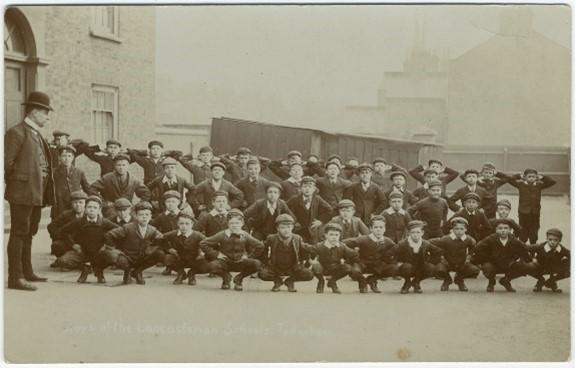A New Way to Learn?
Before the 19th century, Parliament did not interest itself in popular education. Learning was highly regarded but it was the preserve only of the elite – the wealthy nobility and gentry. But with an increasing industrial society, improving literacy for all and the need for technical skills on a large scale was necessary. Until the 19th century there was no organised system of basic education for the majority of people.
In the 1700s there was an increase in charity schools that taught basic subjects and some skills to aid children to gain work. These were financed by public subscription and supported by religious bodies. Those small numbers of children who could benefit would often have to wear uniforms and take part in parades through the street. There were a number of schools in Tottenham, run by members of the local Quaker community, around Tottenham Green and along the High Road, including The Bluecoats, now a public house. Some philanthropic schools – like the Ragged Schools – aimed to improve literacy amongst the most poverty-stricken communities through the study of the Bible.

(PE class at Lancasterian School, Tottenham. 1910. From the collections and © Bruce Castle Museum and Archive )
By 1800 there was a move in favour of providing mass education on a national scale, partly influenced by the ideals of the French Revolution, bringing ‘enlightenment’ to all, and partly due to the growing industrial society needing a better educated workforce. Church schools became popular.
But there was a difficulty in increasing the number of schools due to the shortage of trained teachers. This was overcome to a degree by the adoption of an idea by Andrew Bell and Joseph Lancaster. The idea wasn’t new but the scheme – known as the Lancasterian scheme – operated on a chain principle.
How the Lancasterian system worked
The subject to be taught was broken down into manageable parts and taught by the schoolmaster to older pupils or ‘monitors’. These youngsters then passed what they learnt on to the rest of the children. At a time when ‘economy’ was highly regarded, the Lancasterian scheme quickly won support.
Joseph Lancaster himself was a Quaker. In view of the previous persecution of Quakers and dissenters, he was anxious to avoid denominational teaching (i.e. not based on religion or the reading of the Bible, like the Ragged Schools). The Lancasterian system caught on and was adopted in particular by The British and Foreign School Society. With more education provision, and the raising of interest in providing mass education nationally, so the first steps were being established to lobby for a national education scheme. But that did not come in until the Forster Education Act of 1870 - thanks to the Forster family of Tottenham.
The oldest surviving school in Tottenham - Lancasterian School in Tottenham from 1813
Keen to bring the Lancasterian system to Tottenham, a committee was formed to oversee its implementation. It was named after the founder of the scheme. There was a separate boys school and a girls school run under the Lancasterian scheme in Tottenham. The boys school was originally in the High Road a little to the south of White Hart Lane but moved later to the Church Road site. A visitor book to the Lancasterian School dates from 1813. The visitors were often the subscribers who supported the school, drawn from the local community and were mainly prominent Quakers – such as Luke Howard (1772-1820) and also businessmen and women in Tottenham, including the headteachers of the Hill family of nearby Bruce Castle Schools. On their visit they would record in the daybook what supplies were needed, such as books, slates and pencils for writing, copybooks with ink, quills and sponges.

(A boys class at Lancasterian School, Tottenham, c.1900. From the collections and © Bruce Castle Museum and Archive)
At the beginning there were about 100 boys taught in one room ‘on the improved plan’ of the Lancasterian system. The families of the boys had to pay 1d (one old penny) a week, with the rest subsidised by the committee of subscribers. By 1820 there were 141 boys and 79 girls. By 1864 this had increased to 225 boys and 117 girls. Subjects taught were basic reading, writing and arithmetic, with needlework for the girls, although by 1864 drawing was included for the boys.
It was noted in an entry in the Visitor’s Book (1813-1827) which survives in the archives at Bruce Castle, that some boys were absent from class due to leave approved for ‘gleaning’. This was a reminder of how rural Tottenham was at that time, with families requiring their children to help in the fields to harvest crops or hay for livestock.
By 1870 and the introduction of the Education Act, Lancasterian School became absorbed into the running of elementary schools run by the Tottenham Local Board. The name of its founder and the system that was operated here survives to this day.
Further resources
British History Online - Tottenham: Education
British Schools Museum
A national story from the late 20th century
Two young pupils from Lancasterian Primary School were chosen to be the models for the drawings in the series of the Ladybird Sunstart books during the 1970s. Set in the Caribbean, the series supported African-Caribbean families growing up in the UK, not only with developing reading at home but also reconnecting with and enjoying customs and traditions such as kite-making.

Location
Revolutionary Schooling
King's Road
London
N17 8NN
United Kingdom